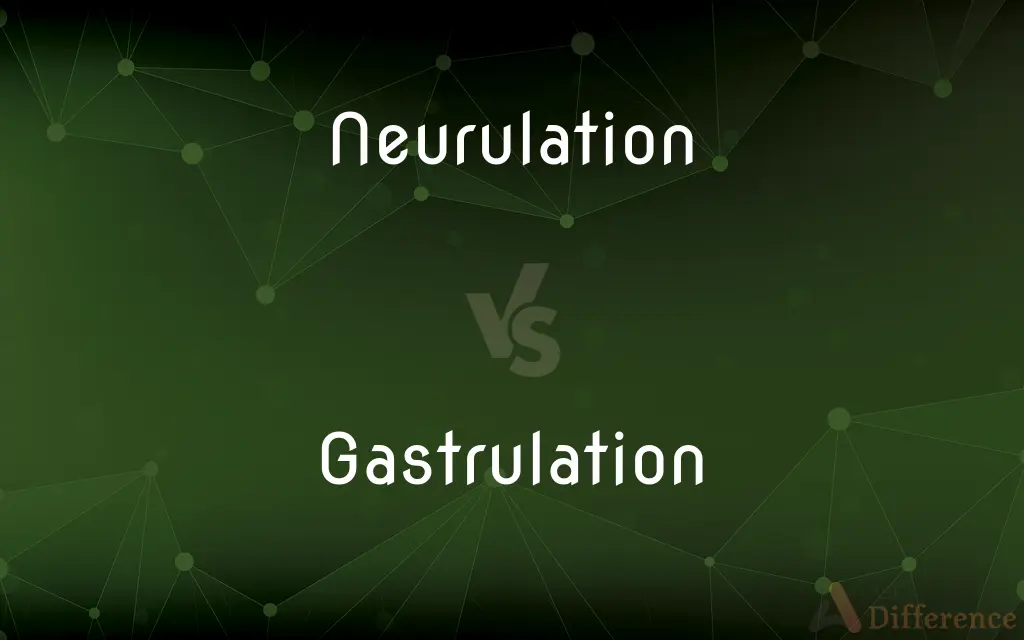Neurulation vs. Gastrulation — What's the Difference?
Edited by Tayyaba Rehman — By Fiza Rafique — Updated on September 27, 2023
Neurulation refers to the formation of the neural tube during embryonic development, while Gastrulation is the process where an embryo reorganizes itself into the three germ layers.

Difference Between Neurulation and Gastrulation
Table of Contents
ADVERTISEMENT
Key Differences
Both Neurulation and Gastrulation are crucial stages in embryonic development, but they cater to different developmental objectives. Gastrulation is one of the early transformative processes where a simple blastula restructures into a gastrula, forming three germ layers: ectoderm, mesoderm, and endoderm. These layers are foundational as they eventually give rise to various organs and tissues. On the contrary, Neurulation follows gastrulation and is specifically geared towards the development of the central nervous system.
During Gastrulation, the embryo undergoes significant cellular movements, including invagination, involution, and epiboly, resulting in the establishment of primary germ layers. Neurulation, on the other hand, primarily sees the ectoderm differentiating into the neural plate, which eventually forms the neural tube. This tube is the precursor to the brain and spinal cord.
While Gastrulation sets the stage for organ and tissue differentiation by segregating cells into defined layers, Neurulation delves deeper into specialized development, honing in on the nervous system. The neural tube formed during Neurulation will evolve into the spinal cord, brain, and other central nervous structures, while the process of Gastrulation is more generalized in creating a foundational layout for the organism.
It's worth noting that while Neurulation and Gastrulation are distinct processes, they are closely interlinked in the chronology of development. The germ layers established during Gastrulation directly influence the events of Neurulation, demonstrating the intricate and sequential nature of embryogenesis.
Comparison Chart
Process Objective
Formation of the neural tube
Reorganization into three germ layers
ADVERTISEMENT
Resultant Structures
Neural tube (precursor to brain and spinal cord)
Ectoderm, Mesoderm, Endoderm
Timing in Development
Follows gastrulation
Precedes neurulation
Primary Cellular Activity
Differentiation of ectoderm into the neural plate
Cellular movements like invagination and epiboly
Significance
Specialized development focused on the nervous system
Generalized restructuring providing foundational layout for the organism
Compare with Definitions
Neurulation
A stage defining the future structure of the nervous system.
Proper neurulation is crucial for the correct development of neurological structures.
Gastrulation
The embryonic phase where three germ layers form.
Gastrulation lays the foundation for future tissue and organ differentiation.
Neurulation
The process of neural tube formation in embryos.
After neurulation, the neural tube will give rise to the central nervous system.
Gastrulation
The stage preceding neurulation in development.
Following gastrulation, the embryo enters the neurulation phase.
Neurulation
A step succeeding gastrulation in embryogenesis.
Neurulation is critical for the formation of the brain and spinal cord.
Gastrulation
A process involving cellular reorganization of the blastula.
Through gastrulation, the simple structure of the blastula transforms into a more complex gastrula.
Neurulation
A fundamental event in the development of the central nervous system.
Abnormalities during neurulation can result in neural tube defects.
Gastrulation
A phase characterized by movements like invagination and epiboly.
The dynamic cellular activities during gastrulation establish the primary germ layers.
Neurulation
The differentiation of ectoderm into a neural plate.
During neurulation, the neural plate will fold to form the neural tube.
Gastrulation
In developmental biology, gastrulation is a phase early in the embryonic development of most animals, during which the blastula (a single-layered hollow sphere of cells) is reorganized into a multilayered structure known as the gastrula. Before gastrulation, the embryo is a continuous epithelial sheet of cells; by the end of gastrulation, the embryo has begun differentiation to establish distinct cell lineages, set up the basic axes of the body (e.g.
Neurulation
Neurulation refers to the folding process in vertebrate embryos, which includes the transformation of the neural plate into the neural tube. The embryo at this stage is termed the neurula.
Gastrulation
The process by which a gastrula forms from a blastula
During gastrulation, cells move into the interior of the embryo
Neurulation
The formation of the embryonic neural plate and its transformation into the neural tube.
Gastrulation
To form or become a gastrula.
Neurulation
(embryology) The process by which the beginnings of the vertebrate nervous system is formed in embryos.
Gastrulation
The stage of embryo development at which a gastrula is formed from the blastula by the inward migration of cells.
Gastrulation
The process of invagination, in embryonic development, by which a gastrula is formed.
Gastrulation
The process in which a gastrula develops from a blastula by the inward migration of cells
Gastrulation
The step that determines the basic body plan of an organism.
The events during gastrulation are crucial for the correct spatial arrangement of tissues.
Common Curiosities
How is Gastrulation initiated in embryos?
Gastrulation starts with the formation of the primitive streak in the embryo.
Are the germ layers formed during Gastrulation significant?
Yes, each germ layer formed during Gastrulation differentiates into specific.
Can abnormalities during Neurulation have consequences?
Yes, disruptions in Neurulation can lead to neural tube defects.
What does Neurulation result in?
Neurulation leads to the formation of the neural tube, a precursor to the brain and spinal cord.
Why is Gastrulation important?
Gastrulation establishes the three germ layers, which give rise to various organs and tissues.
Share Your Discovery

Previous Comparison
Ode vs. Sonnet
Next Comparison
Division vs. BattalionAuthor Spotlight
Written by
Fiza RafiqueFiza Rafique is a skilled content writer at AskDifference.com, where she meticulously refines and enhances written pieces. Drawing from her vast editorial expertise, Fiza ensures clarity, accuracy, and precision in every article. Passionate about language, she continually seeks to elevate the quality of content for readers worldwide.
Edited by
Tayyaba RehmanTayyaba Rehman is a distinguished writer, currently serving as a primary contributor to askdifference.com. As a researcher in semantics and etymology, Tayyaba's passion for the complexity of languages and their distinctions has found a perfect home on the platform. Tayyaba delves into the intricacies of language, distinguishing between commonly confused words and phrases, thereby providing clarity for readers worldwide.














































